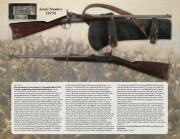Page 155 - 4094-BOOK2
P. 155
LOT 1149
Desirable Historic Custer Range U.S. Springfield Model 1873
Trapdoor Saddle Ring Carbine with Carbine Boot - Serial
no. 39258, 45-70 Government cal., 22 inch round bbl., blue/
casehardened finish, walnut stock. Manufactured in 1875. This U.S.
Springfield Model 1873 Trapdoor carbine, serial number 39258,
is only five serial numbers away from serial number 39253, a 7th
Cavalry issued carbine that is listed as part of a group of Model 1873
carbines recaptured from the Indians after the Battle of Little Big
Horn and used in subsequent U.S. government testing along with a
variety of other types of captured arms in order to see if the Indians
had superior firepower against the standard U.S. military shoulder
arms of the time. Serial number 39253 along with 1196, 3146, 3197,
17485, 17940, 18137, 18141, 18202, 20498, 21573, 21669, 33155,
33815, 34723, 36442 and 42259 are listed as part of this group
of Springfield Model 1873 Trapdoor carbines “captured from the
Sioux and Cheyenne Indians” and used in 1879 government tests as
referenced on page 307 of the 1879 “Annual Report of the Chief of
Ordnance”. The Springfield Armory Museum collection reportedly
has Custer battle attributed 1873 carbines with serial numbers
40173 and 19714. Relevant serial numbers of Model 1873 carbines
can also be found on pages 3-4 of “Serial Numbers of U.S. Martial
Arms, 1st Edition” by the Springfield Research Service, and pages
81-83 of “Custer Battle Guns” (1988 expanded edition) by John S.
Du Mont. This mentioned list of recaptured Model 1873 Trapdoor
carbines is a small amount of a number of these Model 1873
carbines known to have been used in the Battle of Little Bighorn
in June 1876, with any Model 1873 carbine falling below the serial
number of 43700 generally accepted as a possible candidate,
and this specific example being an extremely strong candidate.
Many of these trapdoor carbines saw continued extensive use by
the U.S. Cavalry throughout the Indian Wars out west. In terms
of the American Indian Wars in the late 19th century, no battle is
as famous as the Battle of the Little Bighorn on June 25-26, 1876,
during the Great Sioux War of 1876 (aka the Black Hills War). The
“Battle of the Greasy Grass” as it was known to Native Americans,
was one of the greatest battlefield victories in Native American
history and one of the worst defeats in U.S. history. In the battle, the
Lakota, Northern Cheyenne, and Arapaho fought off an attack and
then pursued and defeated the 7th Cavalry, including destroying
Lieutenant Colonel George Armstrong Custer’s immediate
command. Custer was already a very well-known military leader,
but his death fighting alongside his command against a superior
number of native warriors secured his place in history and has made
“Custer’s Last Stand” one of the most iconic legends of the American
West. Blade front sight and correct ladder rear sight graduated to
1,200 yards, narrow Model 1873 receiver, “MODEL/1873” above an
eagle head and crossed arrows above “US” on top of the high arch
breech block, federal eagle and “U.S./SPRINGFIELD/1873” marked
lock with three-click tumbler, long wrist stock with 9 inch comb,
left mounted saddle bar (absent ring), circled script “P” firing proof
stamped behind the lower tang and a solid buttplate correctly
without compartment. White painted inventory number “139-AC”
on the bottom of the stock ahead of the trigger guard. Includes a
leather carbine boot.
CONDITION: Good, showing unmistakable signs of period frontier
use, exhibiting mottled gray and brown patina, scattered pitting
and general wear, and a period sheet brass repair on the rear sight
ladder. Stock is fair with numerous scattered scars, scuffs, dents,
scratches and cracks including one below the left of the receiver
area, and plenty of character. Absent stacking swivel and sling ring.
Mechanically fine. Carbine boot is good with age related cracking
and wear, and an absent end section on one of the straps. This
Custer range U.S. Springfield Model 1873 Trapdoor carbine would
make a fine addition to any historical American firearms or museum
collection!
Provenance: The James Blanchard III Collection; Property of a
Gentleman.
Estimate: 8,500 - 13,000
Serial Number
39258
153


